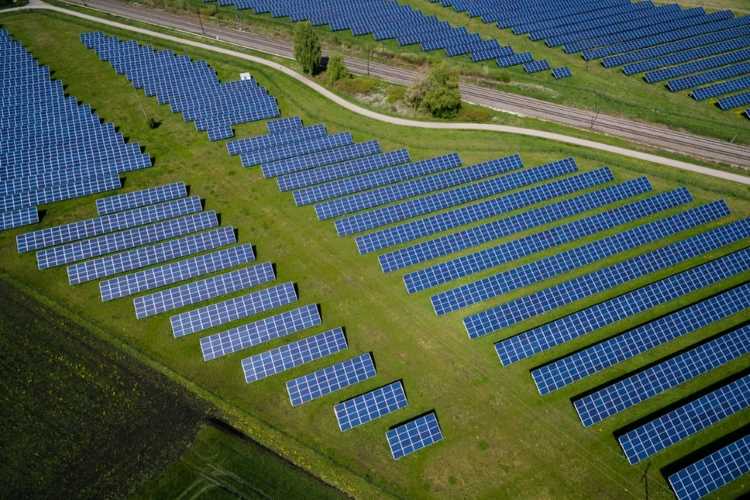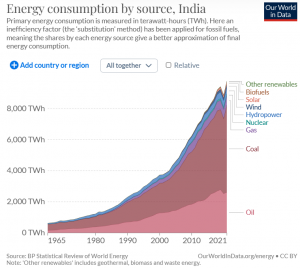
India made significant strides, jumping 20 spots to reach the 67th position among 120 countries in the Energy Transition Index, according to a report released by the World Economic Forum last week. As the world increasingly emphasises on the importance of sustainable energy sources, India stands out as the sole major economy with accelerating momentum across all dimensions of energy transition.
Through advancements in energy equity, security, and environmental sustainability, India has improved its rankings and moved up from its 87th position in 2021 among 115 countries.
The Energy Transition Index not only evaluates countries based on their energy systems but also their preparedness to secure sustainable energy systems. Several states in India have excelled in energy transition, driven by innovative policies. Early initiatives in solar energy by Gujarat and Rajasthan, and in wind energy technology by Maharashtra and Tamil Nadu contributed to the uptake of renewable energy at the national level.
READ | Industrial policy key to economic transformation to a sustainable future
India has also made remarkable improvements in creating an enabling environment, thanks to political commitment, an ambitious reform agenda, infrastructure investments, and a competitive renewable energy landscape.
Achieving universal access to electricity, transitioning from solid fuels to clean cooking options (primarily liquified petroleum gas), and increasing the deployment of renewable energy have all played a role in the country’s improved ranking.
New Delhi has been at the forefront of promoting the widespread adoption of clean energy, positioning itself alongside Singapore as the only major economies demonstrating transition momentum.
China, Indonesia and India are among 55 countries that have improved their Energy Transition Index scores by more than 10 percentage points in a decade. The top three positions are continued to be cornered by Sweden, Denmark and Norway as they had done throughout the past decade.
The Importance of Clean Energy
At a time when the earth is getting hotter due to the heat trapped by greenhouse gas emissions and with island countries like Tuvalu are likely to go under due to rising sea levels, governments across the world have made it a priority to switch to sustainable sources of energy. Without this transition, the fate of the planet will be catastrophic.
However, despite significant progress made by certain countries in adopting clean energy, the current pace of transition falls short of meeting the inclusive and secure targets outlined in the Paris Agreement.
The Paris Agreement signed in 2015 is aimed at tackling climate change by keeping the rise of global temperature below 1.5 degrees Celsius this century. Unfortunately, achieving this target appears increasingly unlikely.
The path towards clean energy adoption faces multiple obstacles, with one major challenge being the shift in focus towards energy security by countries. The ongoing war between Russia and Ukraine has triggered an energy crisis in the Eurozone. Geopolitical and macroeconomic uncertainties have also hindered progress in energy adoption as countries prioritise the maintenance of secure and stable energy supplies over universal affordability. The World Economic Forum stated that these factors have reversed some of the progress observed over the past decade. India remained unaffected by the energy crisis because of its low reliance on natural gas for power generation and higher generation and utilisation of its coal reserves.
Roadblocks in India’s clean energy transition
India hopes to achieve a green energy revolution and the government has set an ambitious target of having 500 GW of installed renewable capacity by 2030 which includes 280 GW of solar power and 140 GW of wind power. However, this is just the beginning of India’s plans for sustainability. The country has proposed a multi-pathway approach to accommodate diverse contexts and development trajectories. India has pledged 50% non-fossil electricity generation by 2030 and net-zero emissions by 2070 as part of its global commitments.

Realising these goals, however, requires cooperation between the central and state governments.
The multi-tier governance of energy production and usage presents a challenge, and industry insiders believe that bridging the gap between the ambitions and implementation capacities of the central and state governments is crucial for effective adoption.
While the central government may set national targets and utilise incentives and penalties to achieve them, the actual realisation of these goals often depends on state priorities and capabilities. For example, India’s progress towards the target of 175 GW of renewable energy capacity is complex.
Even if the country achieves the target, the transition will not be equitable, as only three states have met their individual targets, and 80% of the current renewable energy capacity is concentrated in six states in the western and southern regions. Limited involvement of a handful of states in the energy transition hinders equitable growth.
Another overlooked issue in the process is the unresolved problems within the electricity sector, such as high losses and unreliable supply. An energy transition may further exacerbate these challenges. Policymakers and the government must collectively work towards resolving such issues.
The government also needs to address potential conflicts of interest with states that may intentionally obstruct national goals.
For example, a coal-dependent state is very likely to resist phasing out coal-fired power plants as it is not only a major source of revenue, but such plants also employ millions of people. Balancing regional and national interests in the energy transition presents a delicate challenge for the government and policymakers.
The WEF report also calls for ramping up skilled workforce, public-private collaboration in innovation, and investment in research and development in low-carbon technologies to catalyse green energy transition.
